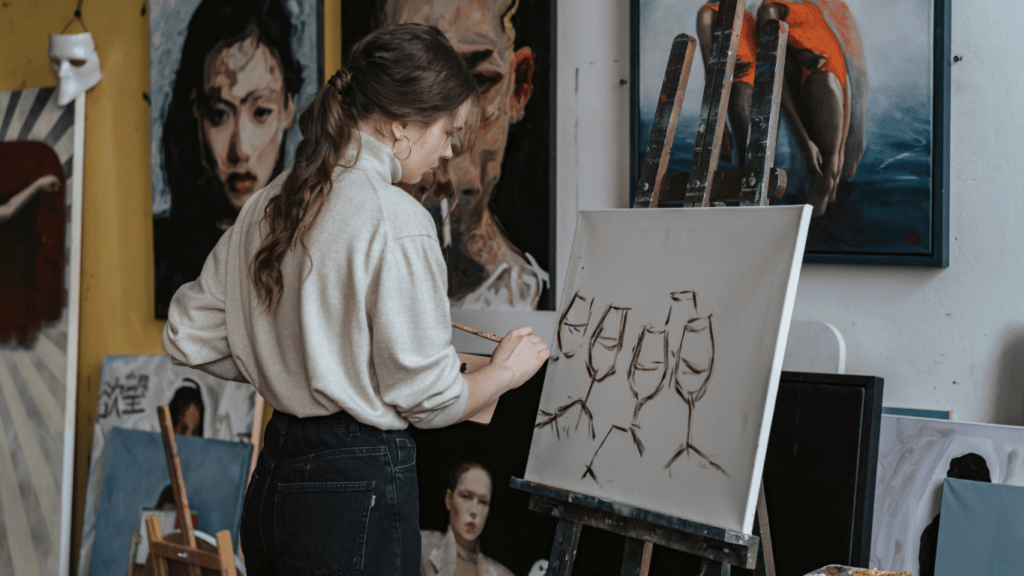Understanding Art Therapy
Art therapy combines creative expression and psychological healing. It’s a powerful therapeutic approach for individuals seeking emotional well-being.
What Is Art Therapy?
Art therapy involves using art materials to explore feelings, develop self-awareness, and manage behavior. It’s facilitated by a qualified art therapist who helps clients engage with creative processes.
Through drawing, painting, or sculpting, individuals express thoughts and emotions that might be difficult to articulate verbally. According to the American Art Therapy Association, this method supports mental health through nonverbal communication and personal insight.
Benefits of Art Therapy
Art therapy offers numerous benefits:
- Emotional Insight: Clients often discover hidden emotions and patterns, which leads to greater self-awareness and understanding.
- Stress Relief: The creative process can significantly reduce stress and anxiety. Painting or drawing provides a calming effect.
- Enhanced Coping Skills: Participants develop stronger strategies for dealing with emotional trauma or everyday stressors.
- Improved Self-esteem: Creating artwork fosters a sense of achievement and boosts confidence. Recognizing one’s creative abilities positively impacts self-worth.
- Nonverbal Communication: For those struggling to verbalize their feelings, art provides an alternative method for expression, aiding in mental health improvement.
These benefits make art therapy a valuable tool for emotional healing and psychological well-being.
Qualifications of an Art Therapist
Qualified art therapists blend creativity with psychological expertise. Finding a qualified professional ensures effective therapeutic outcomes.
Educational Requirements
Art therapists must earn a master’s degree in art therapy or a related field. Programs typically include courses in psychology, counseling, and art techniques. Accreditation by the Commission on Accreditation of Allied Health Education Programs (CAAHEP) or similar bodies assures the program meets industry standards.
Licensing and Certifications
After completing their degree, art therapists need to obtain licensure. Licensing requirements vary by state. Most states require passing the Art Therapy Credentials Board Examination (ATCBE).
Additionally, the Art Therapy Credentials Board (ATCB) offers two key credentials: the Registered Art Therapist (ATR) and the Board Certified Art Therapist (ATR-BC). Pursuing these certifications demonstrates a commitment to maintaining high professional standards.
Finding a Qualified Art Therapist

Locating a skilled art therapist enhances therapeutic outcomes. Consider these steps to ensure you find the right professional.
Researching Online
Begin your search using dedicated platforms like Psychology Today and TherapySites. These directories list licensed therapists, including art therapists, with detailed profiles. Look for information about their qualifications, areas of expertise, and client reviews. Ensure the therapists are credentialed by checking their ATR or ATR-BC status on the Art Therapy Credentials Board website.
Checking Professional Associations
Refer to professional bodies like the American Art Therapy Association (AATA) and the Art Therapy Credentialing Board (ATCB). These organizations maintain directories of certified art therapists. Membership in these associations often indicates adherence to high professional standards and ongoing education.
Seeking Recommendations
Ask for recommendations from trusted sources like your primary care doctor, mental health professionals, or friends and family. Personal referrals provide insights into a therapist’s effectiveness and approach. Schools, community centers, and local hospitals can also suggest reputable art therapists, offering additional reassurance of their qualifications.
Evaluating an Art Therapist
Finding an art therapist with the right qualifications and approach is crucial for effective therapy. Here are some key aspects to consider when evaluating a potential art therapist.
Interview Questions to Ask
Asking the right questions ensures the therapist meets your needs:
- What are your qualifications and certifications? Confirm the therapist holds a master’s degree in art therapy or a related field, and check for credentials like ATR or ATR-BC.
- How much experience do you have? Inquire about their experience working with individuals facing similar issues.
- What is your approach to art therapy? Understand their therapeutic style to see if it aligns with your expectations.
- Can you provide references or testimonials? Request client feedback to gain insights into their effectiveness.
- What are your fees and payment options? Clarify costs upfront to ensure affordability.
Assessing Compatibility
Compatibility between you and the therapist impacts therapy outcomes:
- Trial session: Schedule an initial session to gauge comfort and communication.
- Therapist’s demeanor: Assess if their personality and approach make you feel understood and supported.
- Flexibility and availability: Ensure their schedule matches yours to maintain consistency in sessions.
- Communication style: Confirm if their way of explaining concepts suits your preference for detailed or simplified information.
- Client feedback: Review testimonials to identify consistent patterns in client satisfaction.
Prioritizing these aspects helps in selecting an art therapist who can effectively support your emotional well-being through art therapy.

 Anna Freehill, a key contributor to Avant Garde Artistry Hub, plays a vital role in shaping the platform’s vision. As an author and collaborator, she helps bridge the worlds of art and technology, offering insightful articles that guide artists through the rapidly evolving creative landscape. Anna’s dedication to highlighting art's therapeutic value has contributed to the platform’s focus on mental and emotional well-being through creative expression.
Her involvement in building Avant Garde Artistry Hub has been instrumental in providing valuable resources to artists seeking to enhance their careers. Whether through her writing on business strategies or her support in platform development, Anna is committed to fostering a space where artists can thrive and embrace the future of art.
Anna Freehill, a key contributor to Avant Garde Artistry Hub, plays a vital role in shaping the platform’s vision. As an author and collaborator, she helps bridge the worlds of art and technology, offering insightful articles that guide artists through the rapidly evolving creative landscape. Anna’s dedication to highlighting art's therapeutic value has contributed to the platform’s focus on mental and emotional well-being through creative expression.
Her involvement in building Avant Garde Artistry Hub has been instrumental in providing valuable resources to artists seeking to enhance their careers. Whether through her writing on business strategies or her support in platform development, Anna is committed to fostering a space where artists can thrive and embrace the future of art.